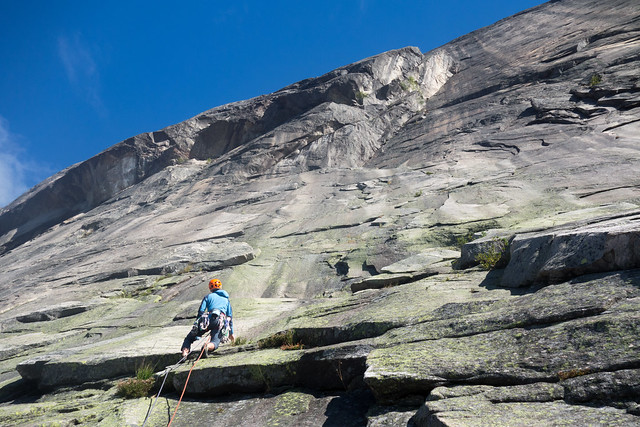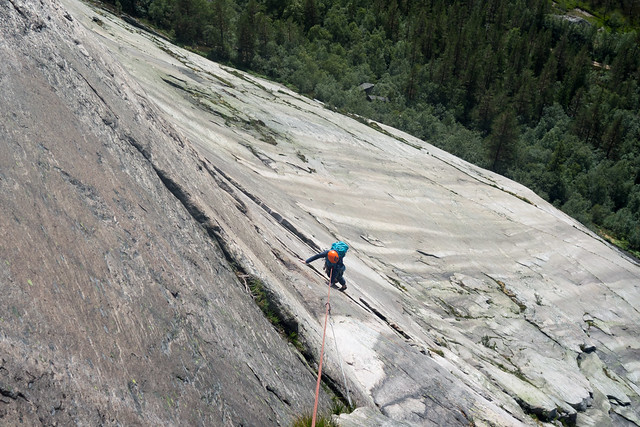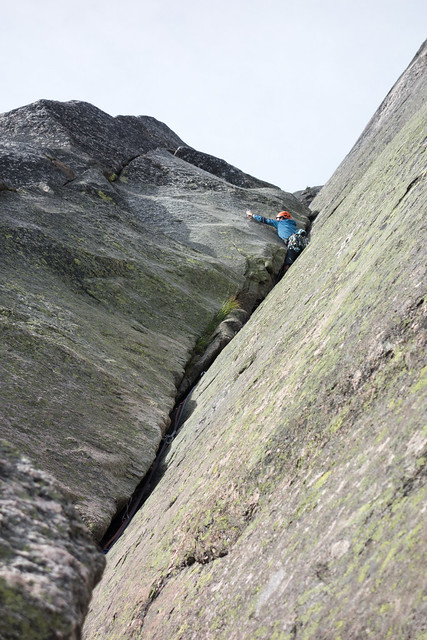 |
Anna leading the penultimate slab pitch
|
At 7am I was slightly worried about our decision to wait until Sunday in order to climb Hægar, which was the planned main event for the weekend. I lay in my tent listening to the strong gusts of wind shake the trees regularly. Strong winds and slab climbing are far from being my favourite combination, particularly when the wind is across the face. However, a quick check of the wind direction raised my optimism that the ridge curving to the east of the main face would block it to some degree. Once we were off the initial slab pitches and into the corner system hopefully we would get further shelter.
Hægar is a route that has been on my wish list for a number of years, but only in more recent times has it found its way towards the top. That's partly because I'm generally climbing better (when not injured), meaning the difficulties have become manageable, and also partly because I'm not getting any younger. Waiting until I become an even better climber, or more to point when I have more headroom to ensure the onsight, is something I probably shouldn't bank on too much. There's routes that will always be too hard for me and those I will never know without trying, and Hægar certainly fell into the latter category. It's around 500m and graded n6+, which is generally right at the limit of my trad onsight ability. That said, a number of friends who I would consider to be roughly equal ability had already climbed the route, which gave me optimism, and I also suspected the route wasn't actually n6+, which I will come back to later.
 |
Hægar from the valley. It climbs the obvious hanging corner in the centre of the photo
(Photo by Anna Kennedy) |
Anna, Angela and myself would climb the route as a three. Usually I'm not keen on climbing as a three as I like leading above all else and climbing as a three naturally means seconding more than I lead. It's nice to have company at the belays but I'd rather be on the sharp end. It's the leading time that stays in my memory longest. In the case of Hægar though nobody but me was putting their hand up to lead the two crux pitches, meaning quality of leading time would hopefully make up for lack of quantity. I expected our pace to be slower but we had climbed efficiently as a three the previous day on Gone with the Weed so there were no serious concerns in that department.
The climbing didn't properly start until about 150m of grassy breaks and easy angled slab had been climbed unroped. As hoped, we were in the lee of the wind. We had three guide descriptions for the route, but none were particularly great and none described the starting point well. The logical place to rope up looked to be a broad grassy ledge that formed to top of a large 'C' shaped feature that we had climbed to the top of. The initial emphasis in any case looked be to set up the main crux slab pitch, which lay in the upper half of the slab, with enough rope to reach the start of the giant hanging corner directly above.
 |
| Anna and Angela reaching the starting ledge of Hægar |
I did a short first pitch up and rightwards to where the Rockfax topo showed the climbing to properly to start. In reality this definitely needed pitching, and once at the shelf where the climbing supposedly started much of the rock was too loose to place cams behind for a belay. Fortunately a further ten metres brought me to a comfortable, well-protected shelf. Anna then led a similar short pitch to where the main slab pitch looked to start. Possibly we could have linked these pitches in retrospect, but I suspect not.
 |
| Anna leading the penultimate slab pitch |
The main slab pitch was surprisingly good, with plenty of interesting moves and very little in the way of pure friction climbing. It deviously weaved a line through a series big hanging flakes amidst otherwise fairly blank slab, requiring short traverses to link these, with the crux coming right at the top. This consisted of some thin edges for the feet and not much for the hands, but with a good hand ledge to aim for up and right. The hard moves looked fairly short lived, and easy to plan from the ledge in advance, and so a little bit like a boulder problem. Less reassuring was the gear. The Rockfax description stated it was protected by big cams. Either the route has changed, or this information is simply wrong as the vital gear came in a smaller form a few metres to my left and below the level of my feet, and it wasn't a cam. This meant a moderate pendulum were I to fall off the crux, but in reality I was more worried about landing back on the ledge from where the harder climbing began. The crux passed with relative ease though and, as with any sequence of slabby moves on edges pointing the right way the moves were as much about edging confidence and good body tension. From above the crux a short sloping shelf then led leftwards to the belay at the base of the corner. I paused to fiddle with gear at the start of the shelf but eventually gave up. My last piece of gear still lay below the crux but in reality the leftwards traverse was a doddle, just a little exposed. The wandering nature of the top of the pitch without gear meant the crux wasn't ideally protected for the second, however nobody seemed to complain.
 |
| Anna seconding the slab crux on Hægar |
The first pitch of the corner, led my Angela, was only n5, but hard enough to not be easy, and also to made me question what the next pitch, rated four grades harder would feel like. The pitch looked from below as though it would simply follow the corner for the duration, but in reality it was easier to briefly escape leftwards in the lower part and then to break out rightwards in the upper half, up the centre of a well-featured hanging slabbing slab.
 |
| Angela leading the first pitch of the corner (Photo by Anna Kennedy) |
Angela's belay was, shall we say, interesting. Two tiny number 3 and 4 Wild Country Zero Friends instead of the two neighbouring trees on the comfortable, expansive belay ledge. Admittedly one of the trees rocked a little bit at the base, but on a ledge this generous it looked difficult to dislodge anybody of moderate size if sitting down in the middle of it. A quick rejig of the belay anchors and I was ready to go.
The main 6+ corner was fantastic. One half of the right facing corner was formed by the broad slab, whilst the other was an overhanging wall trending left to right. It was consequently slabby for the feet but overhung for the hands. The most technical moves were arguably at the start of the pitch, and needed some gymnastic footwork via small edges to regain the corner from the belay ledge. Thereafter there was plenty of big layback moves, largely on good holds and with some bridging rests in order to place gear. There was also plenty of puffing my my part. From the belay it had looked as though I would be plugging the corner crack with cams the whole way up, but there proved to be perfect nut placements for much of the pitch where the crack frequently narrowed. The steep moves around the lip, where the roof ended, provided a fine finale to the pitch. On first attempt I tried to find some bridges to make the moves less strenuous but I soon began to lose my shape, and so I down-climbed back to a good resting point. On second attempt I went all in with the laybacks and swiftly reached the lip. A little gear faff followed as the cam that I had placed in the broad cleft directly behind the lip immediately rotated as soon as I started to take the ropes in. For fear of losing a walking cam I was put back on belay so that I could down-climb to just beneath the nose again in order to remove it.
 |
| Me near the start of the crux corner pitch (Photo by Anna Kennedy) |
 |
| Angela moving around the lip of the roof (Photo by Anna Kennedy) |
The next pitch gained an offwidth crack. It was described as slippery in the Rockfax guide and Anna quickly confirmed this to be the case when her feet slipped whilst laybacking. Evidently the crack needed climbing in a more offwidth fashion by jamming whatever size leg part fitted the crack best. It was escapable at half height by moving left onto a slab, but I'm glad that Anna stayed in the crack for the duration as this looked both the strongest and most integral line. It was one of those banana skin pitches though that could rob one of an onsight ascent having done all the hard work on the crux pitches prior. Fortunately there enough good edges around the crack or within it to avoid too much thrutching.
 |
| Anna in situ in the offwidth crack |
The next pitch was an easy scramble, which I scampered up without stopping to place runners until beneath the final corner, which would be Angela's lead. This looked deceptively steep in the upper half where the crack swung back sharply rightwards, but it was partly a trick on the eye and reasonably steady in reality.
We were beginning to catch the wind a little towards the top of the route and were now in the sun's shadow, meaning things felt a little chilly. A brief look at the small pockets of violently swaying trees in the valley below made me glad that at least we were largely sheltered from the gusts.
 |
| Angela leading the final corner pitch (Photo by Anna Kennedy) |
It was down to Anna to lead the easy final slabby pitch, albeit largely gearless, to the top of the route from where it was a short exit leftwards to gain the hilltop proper. It was around 7pm by this point, and with a 90 minute descent and four hour drive still to come, we were all set for an after midnight arrival back in Oslo. We were a long way off setting any speed records but that was probably due to us all leading pitches that were individually challenging to us all. Consequently the pace of ascent was fairly uniform throughout, irrespective of grade.
We had contemplated an abseil descent down an equipped route called Hoph Zing further right but we were unfamiliar with its exact whereabouts and at this late hour it seemed a safer bet to cut our losses and take the footpath. We were at least rewarded with a bounty of cloudberries soon after starting our descent, which were too good to pass by, especially given they were my first encounter with them. This of course led to further delays due to an unspoken agreement not to continue until all the cloudberries were consumed.
 |
| Cloudberry booty (Photo by Angela Wong) |
As with Gone with the Weed the previous day, the grading for Hægar seems a little contentious. It was originally graded UIAA 6+ in the German Gå Telemark guidebook but subsequently graded n6+ in the Rockfax and OUS fjell guides, which is effectively a grade increase since UIAA 6+ equates to n6. In my opinion both cruxes were n6. It's a very rare occurrence that I onsight 6+ and all the climbing on Hægar felt reasonably in hand rather than at my onsight limit. In UK terms it was definitely E1 and either 5b or c.
Hægar must rank as one of the best trad routes that I have climbed. I'd say it was better than Mot Sola on the basis that the 6+ corner is better than any pitch on Mot Sola. The slab pitches were also far more interesting than those on Mot Sola's original start and add to the route's variety. With so many partially bolted routes on Hægefjell, including at the belays, it was good to climb a route that was totally free of any. It added to the commitment and thus made the outcome all the more rewarding.











“This post gave me a fresh perspective on the subject. I’ll definitely keep these points in mind moving forward.” customized bid boxes
ReplyDelete